The elephant foot shows a remarkable growth shape. Here you can find out everything you should know about the elephant foot.
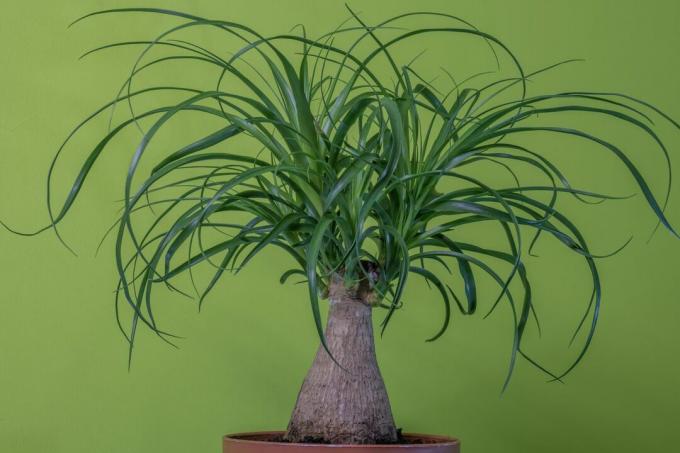
The elephant foot (Beaucarnea recurvata) with its thick, upwardly tapering trunk actually looks like the pounders of the gentle savannah animals. But it's not just this extraordinary appearance that makes it a popular houseplant. The trunk holds unimagined storage capacities, which give the elephant foot an incredibly high level of adaptability and resilience. This makes it the ideal plant for budding room botanists. However, a healthy, pretty elephant's foot needs a few things to be happy.
contents
- Elephant foot: origin and characteristics
- Buying an elephant foot: This is important to note
- Propagate the elephant foot yourself: is that possible?
-
Maintain elephant feet like a pro
- Water the elephant foot properly
- Fertilize elephant foot properly
- Repot the elephant foot
-
When and how to cut the elephant foot?
- Cutting off the elephant's foot: when is the right time?
- How to cut the elephant foot correctly?
-
Elephant foot: diseases and brown leaves
- Elephant foot: the most common diseases
- Elephant foot: why do the tips of the leaves turn brown?
Elephant foot: origin and characteristics
The elephant foot is native to only one state in Mexico. Here the succulent tree grows in dry, tropical forests and reaches heights of up to 9 meters. As a houseplant, sizes of up to 1.5 meters can be achieved. However, it takes a long time to achieve this size because the tree grows very slowly. Here is some information about this extraordinary and yet undemanding room tree:
- Latin name: Beaucarnea recurvata
- Common names: bottle tree, water palm
- genus Beaucarnea
- Family: Dracaenaceae
- Age: Up to 100 years
- Leaves: Slender; up to 50 cm long
- Flowers: ovate to paniculate; white inflorescence
- Trunk stores water and nutrients
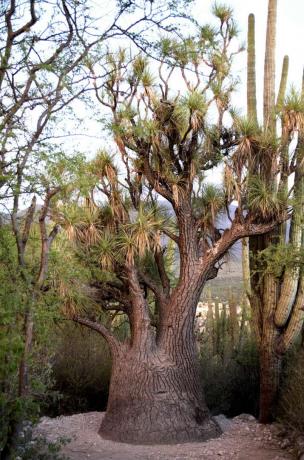
As with the dragon tree, the sprouting leaves die from bottom to top over time. Only the shoots are leafed. Flowers are very rarely formed in indoor culture. Always keep an elephant tree out of the reach of small children and pets as it is poisonous. More on the subject "Elephant foot: poisonous or not?”Can be found in our special article.
Buying an elephant foot: This is important to note
You can buy seeds as well as already grown plants in the garden center, online trade or sometimes in the supermarket. The older and bigger the plant, the more expensive it is of course. When buying, make sure that the plants are not in an area with a draft. The leaves should be bright green. Yellowish or brown leaves indicate incorrect care and a weakened, ailing plant. You should also be on the lookout for a pest infestation. Better to stay away from plants with cotton wool spots or misshapen leaves.

Propagate the elephant foot yourself: is that possible?
The exotic can be increased by you as you wish. In older specimens, side shoots can form in the leaf axils. These can be for a Propagation of cuttings be used. The side shoots are cut off with a clean knife and placed in a nursery pot with a mixture of sand and peat. The cutting will soon take root in a comfortably warm, light-protected place. Make sure the soil temperature and humidity are constant. In order to guarantee the humidity, a foil hood is put over the cultivation pot. Unfortunately, the growth of the cuttings often does not correspond to the typical appearance of an elephant tree, which is why the variant of choice is usually the cultivation of seeds. Although the in-house production of the seeds is more of a special case because of the rare flowering, the seeds can also be purchased online. The procedure for rearing from seeds is as follows:
- Soak the seeds in lukewarm water for a few hours
- Fill the seed tray with a mixture of sand and clay
- Sow seeds on the ground and cover lightly with soil (light germinator)
- Pour lightly
- Location: bright and warm; up to 25 ° C
- Use foil hood
- Always keep the substrate moist
- Germination time: several weeks
Ideally, a warming mat is placed under the seed tray so that the floor temperature remains constantly high. After the first leaves have formed, enough roots have formed. The mini elephant foot can now be moved into a larger vessel.
Maintain elephant feet like a pro
So that the elephant foot feels comfortable with you, it is important to bring Mexico into your living room. You don't have to wear sombreros, but you need plenty of light and warmth. However, the blazing summer midday sun quickly leads to sunburn. Even drafts are not tolerated - otherwise the elephant will quickly turn into an ice foot. A nice place at a west or east window is therefore ideal. The pot is occasionally turned a quarter turn so that the trunk grows straight in a window seat. You can find out what you can use to sweeten your elephant's foot in summer and how you can take care of it over winter in our article on Elephant foot care.

Water the elephant foot properly
The thickened trunk is used to store water to protect against long dry periods in the Mexican homeland. As a houseplant, this has the advantage that the elephant tree rarely needs to be watered. So, especially in spring and autumn, the tree doesn't hold it against you if it is forgotten. Hard irrigation water is also tolerated. In winter, watering is only done in small amounts if necessary. In summer you should water regularly and thoroughly, but only when the substrate has completely dried out.
Fertilize elephant foot properly
The trunk not only has a water store but also a nutrient store. Therefore, fertilization is only moderate during the growth phase. During this time, cactus fertilizer is used in the irrigation water every four weeks. Alternatively, green plant fertilizer can also be used in half the concentration. Whether cactus or green plant fertilizer, it is generally recommended to use an organic fertilizer variant, because the nutrients it contains are released over a longer period of time. This reduces the risk of over-fertilization. After repotting, there is no fertilization for the next eight weeks, as the new substrate provides enough nutrients. More information about the Fertilizing the elephant tree can be found in our special article.
Repot the elephant foot
Due to its slow growth, the elephant foot does not need to be repotted often. Only when the trunk has the same circumference as the pot or the root ball is pushed out of the pot does the leisurely plant need a new home. This is the case approximately every three to five years. How and when exactly you can best repot your elephant tree can be found in our article on Elephant foot cutting and repotting.
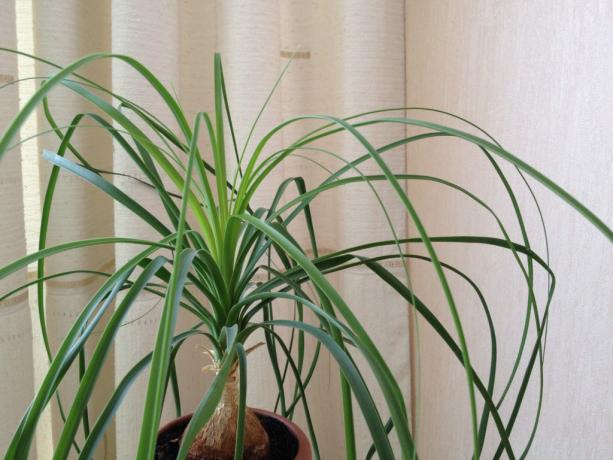
Summary Caring for the elephant's foot like a professional:
- Location: bright and warm; East or west window; no drafts
- Watering: When the substrate is completely dry
- Fertilize: In the growth phase every four weeks with cactus fertilizer, half a dose of green plant fertilizer
- Repotting: Every three to five years
When and how to cut the elephant foot?
The leaves of the elephant tree can be over a meter long. The thought of pulling out the scissors to cut the leaves to the desired length quickly comes up. Unfortunately, the pruning results in unsightly brown leaf tips. The temptation to remove them is great. The vicious circle that has started ends then, to the suffering of the houseplant owner, usually in a short hairstyle. Then it's better to cut off the shoots completely to make space for new ones.
Cutting off the elephant's foot: when is the right time?
It is best to cut at the beginning of the growing season in spring.
How to cut the elephant foot correctly?
The trunk is cut with a clean and sharp knife at any height above the foot. The cut surface is then disinfected and sealed. Wound closure with wax serves to protect against drying out. Your elephant tree will soon sprout again at the interface. Usually two to three shoots are formed.
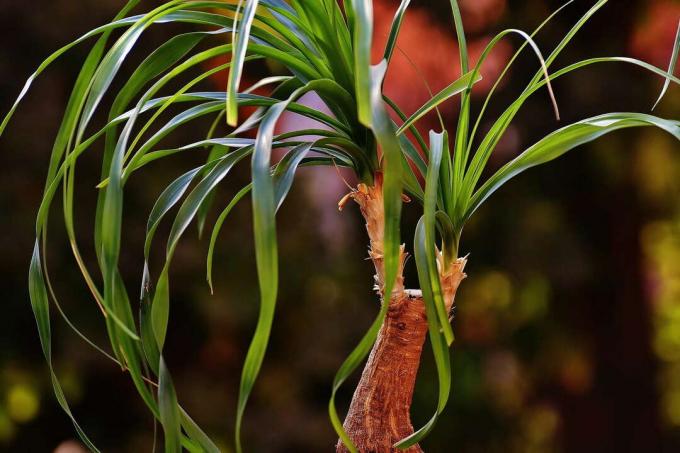
Elephant foot: diseases and brown leaves
A correctly cared for elephant tree despite diseases and pests, but if the tree is wrong or is not watered correctly, the exotic quickly becomes ailing.
Elephant foot: the most common diseases
A few diseases and pests are particularly common with improper care:
Mold and rot (fungal infection)
- Symptoms: Yellow, soft young leaves
- Cause: too much watering
- Countermeasure: remove damaged roots; repot in dry earth; pour less
Mealybug
- Symptoms: white streak; small animals covered with a white wax layer on the underside of the leaf and the leaf axils
- Cause: Introduced by other plants or when you bought it
- Remove infected leaves; Isolate plant; treat other plants with lye solution (precaution)
Spider mite, Scale insect
- Symptoms: Woven Web; Spots or deformities on the leaves that look like cotton balls
- Cause: low humidity
- Scrape off the infected leaves with a knife and take a cool shower; higher humidity
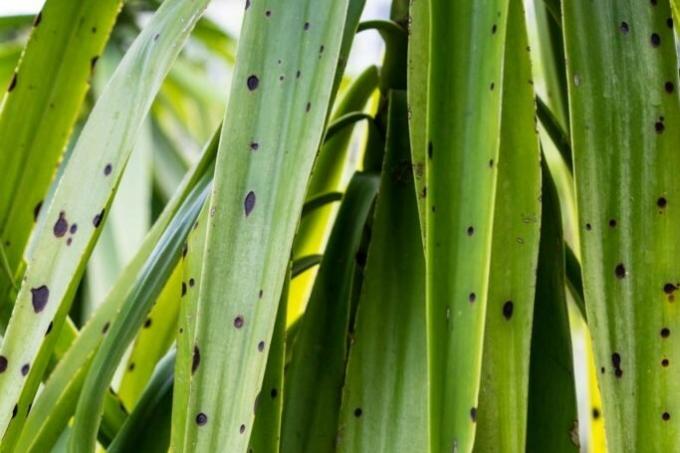
Elephant foot: why do the tips of the leaves turn brown?
The lower leaves naturally turn brown over time. You first have to pay attention if as many new leaves do not grow back as old ones fall off. There are many reasons for this:
- Cutting back the leaves
- Too frequent watering; Waterlogging
- Sunburn from excessive exposure to the sun
- Winter: Too much heating air; low humidity; too warm; Lack of light; too little poured
- Leaves hit the floor / walls
- Too few nutrients from a saucepan that is too small
- Temperatures too cold
Care must be taken to ensure that the leaves do not turn brown in the first place. Here you will find everything for the right one Care of elephant foot and what can be done in an emergency with brown leaves.
